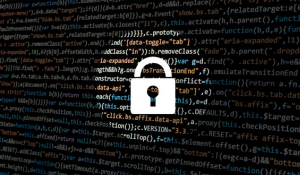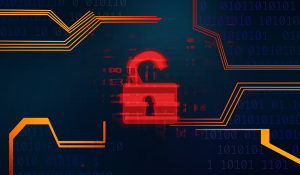Unseen Invaders: Exploring the World of Computer Worms
In our increasingly digital landscape, the importance of understanding and defending against computer worms cannot be overstated. Whether you're a...
11 min read
 DriveLock
Sep 19, 2023 10:03:07 AM
DriveLock
Sep 19, 2023 10:03:07 AM

The reliance of modern organizations on interconnected technology has amplified the potential impact of malicious software. From disrupting daily operations and compromising sensitive data to inflicting significant financial losses, computer viruses pose a serious threat to businesses and individuals alike. These invisible, malicious pieces of code can infiltrate your systems, wreak havoc on your operations, and jeopardize the security of sensitive information.
| TABLE OF CONTENTS |
This post will dissect the anatomy of these digital adversaries, examining their diverse forms and the cunning methods they employ to infiltrate systems. Beyond understanding the threat, we will focus on equipping you with the knowledge to identify the signs of infection and, crucially, implement effective strategies to safeguard your digital assets.
At their core, computer viruses are a form of malicious software, often referred to as malware, specifically crafted to infiltrate and impair the normal operation of digital devices, from individual computers to extensive network infrastructures. What distinguishes a virus is its parasitic nature: it requires a host program or file to embed itself within. Once this infected host is executed or accessed, the virus springs into action, potentially replicating its code and spreading to other susceptible files or systems. This propagation often occurs surreptitiously, without the user's awareness or explicit permission, making early detection a significant challenge.
Key characteristics of a computer virus include:
Replication: A virus can create copies of itself and embed them within other files or programs on the infected computer. This allows it to spread to other systems when infected files are shared or transferred.
Destruction or Manipulation: Once activated, a computer virus can perform various harmful actions, such as corrupting data, deleting files, or altering the normal operation of the infected computer.
Concealment: Viruses often attempt to hide their presence from the user and security software, making them difficult to detect until they execute their malicious code.
Payload: Most viruses carry a payload, which is the malicious code or action they are designed to perform. This can range from simply spreading the virus to more destructive actions like data theft, espionage, or system takeover.
Trigger: Viruses typically have a trigger mechanism that determines when they activate. This can be based on specific conditions, dates, or events, or it may be triggered by a predefined action taken by the user.
Computer viruses are considered a form of malware (malicious software) and are illegal in most jurisdictions because of their potential to cause harm and compromise the security and privacy of computer systems and their users. Protection against computer viruses usually involves using antivirus software, maintaining up-to-date operating systems and software, and practicing safe computing habits such as not opening suspicious email attachments or downloading files from untrustworthy sources.
Beyond this fundamental definition, the landscape of computer viruses has evolved considerably. Modern threats often exhibit sophisticated behaviors that go beyond simple replication and file corruption. Here are three contemporary examples illustrating this evolution:
Ransomware Viruses: While ransomware itself is a type of malware, certain variants exhibit virus-like propagation capabilities. These threats not only encrypt a victim's files and demand a ransom but also actively spread across a network to infect other vulnerable machines, maximizing the attacker's leverage and potential payout. The "wormable" nature of some ransomware strains makes them particularly dangerous for organizations with interconnected systems.
Fileless Viruses Leveraging Scripting Engines: Modern operating systems and applications rely heavily on scripting engines like PowerShell or JavaScript for automation and dynamic content. Fileless viruses exploit these legitimate tools by injecting malicious code directly into the computer's memory or leveraging existing system processes. Because they don't rely on traditional executable files, they can evade detection by conventional file-scanning antivirus software, posing a significant challenge to traditional security measures.
Botnet-Spreading Viruses: Some viruses are designed to turn infected computers into "bots" that are part of a larger network controlled by an attacker, known as a botnet. These viruses often spread through vulnerabilities or by exploiting weak credentials. Once a computer is compromised, it can be commanded to perform malicious activities, such as launching distributed denial-of-service (DDoS) attacks against websites or spreading further malware. The Mirai botnet, which targeted IoT devices, exemplifies the potential scale and impact of such viruses.
The threats lurking within our computers come in a surprising array of forms, each engineered with distinct mechanisms for infiltration and harm. Recognizing these varied characteristics is a fundamental step towards building robust digital defenses. Let's explore the common categories of computer viruses and understand the unique ways they can impact your system and data.

Here are some common types of computer viruses, along with brief descriptions of each:
File Infector Virus: Imagine a parasite that latches onto legitimate programs, the very applications we rely on daily, such as .exe files that launch software or .dll files that provide essential functions. When you unknowingly run an infected program, this virus awakens and can then spread its malicious code to other executable files lurking on your system. The consequences can range from annoying malfunctions to the outright corruption or alteration of your valuable data, potentially rendering your applications unusable.
Macro Virus: These insidious viruses target the built-in automation features, known as macros, found within popular document and application software like Microsoft Word and Excel. Think of macros as mini-programs within these files. When an unsuspecting user opens a document harboring a macro virus, the malicious code embedded within can automatically execute. From there, it can replicate itself to other documents you open or create, potentially spreading across your entire suite of files and performing unwanted actions like modifying content or even initiating other harmful processes.
Boot Sector Virus: Deep within your computer's storage lies the master boot record (MBR), a critical section that dictates how your operating system starts up. Boot sector viruses target this fundamental area, or even the boot sectors of removable media like older USB drives. By infecting the MBR, these viruses gain control early in the startup process, potentially preventing your computer from booting altogether or loading their malicious code before your operating system even has a chance to launch. This can lead to system inoperability and data inaccessibility.
Multipartite Virus: As the name suggests, these are particularly troublesome viruses that employ a multi-pronged attack strategy. They possess the ability to infect not just executable files but also the boot sector of your storage devices. This dual infection mechanism makes them significantly more resilient and challenging to eradicate. If one infection vector is cleaned, the other might still be present, allowing the virus to re-infect the system, demanding a more thorough and specialized removal process.
Polymorphic Virus: To evade detection by antivirus software, polymorphic viruses employ clever disguise tactics. Each time they replicate and infect a new file or system, they subtly alter their own code while keeping their malicious functionality intact. This constant shape-shifting, often achieved through encryption and minor code modifications, makes it difficult for signature-based antivirus programs to recognize and block them, requiring more sophisticated behavioral analysis techniques for effective detection.
Metamorphic Virus: Taking the art of disguise to an even more advanced level are metamorphic viruses. Unlike their polymorphic cousins that make minor alterations, metamorphic viruses completely rewrite their code with each new infection. They essentially generate a brand-new version of themselves, making it incredibly challenging for traditional signature-based detection methods to keep up. Each infection appears as a unique and unfamiliar piece of code, demanding highly adaptive and heuristic-based security solutions.
Resident Virus: These stealthy viruses, once executed, don't just run and disappear. Instead, they embed themselves directly into your computer's active memory (RAM). From this concealed position, they can remain active in the background and silently infect files as you access or close them. Their persistent presence in memory makes them harder to detect through simple file scans, as the malicious code isn't always directly associated with a specific file on your storage.
Non-Resident Virus: In contrast to resident viruses, non-resident viruses are more fleeting in their activity. They operate by attaching themselves to executable files. When an infected file is launched, the virus code runs briefly in the system's memory, carrying out its infection routine, such as spreading to other files. Once the infected host program is closed, the virus becomes inactive until another infected file is executed. This makes their activity more localized to the execution of infected programs.
Network Virus: In our interconnected world, network viruses exploit vulnerabilities within network protocols or services to rapidly spread across multiple computers within a network. Imagine a digital contagion that leaps from one machine to another through the very pathways that allow our computers to communicate. These viruses can quickly saturate network bandwidth, leading to significant slowdowns and disruptions in network operations, potentially crippling organizational productivity.
Fileless Virus: Breaking away from the traditional model of infecting files, fileless viruses operate by exploiting vulnerabilities directly within a computer's memory or running processes. They don't necessarily write malicious code to the hard drive, making them particularly challenging for conventional file-scanning antivirus software to detect. Instead, they might inject malicious scripts into legitimate processes or leverage system tools in unintended ways, leaving a minimal footprint on the file system.
Computer Worm: While often grouped with viruses, worms possess a critical distinction: they are self-replicating and can spread autonomously across networks without needing to attach themselves to a host file. They exploit network vulnerabilities to propagate from one computer to another, often consuming system resources and network bandwidth in the process. While they don't always corrupt files like traditional viruses, their rapid spread can cause significant disruption and can be used to deliver other malicious payloads.
Ransomware: This particularly damaging form of malware takes your digital life hostage. Once it infects your system, it encrypts your valuable files, rendering them inaccessible, or locks you out of your entire system. The attackers then demand a ransom, typically in cryptocurrency, in exchange for the decryption key or to restore access. The consequences can be devastating, leading to significant data loss and financial burdens for individuals and organizations alike.
Keylogger: Operating in the shadows, keyloggers are designed to secretly record every keystroke you make on an infected computer. This allows cybercriminals to capture a treasure trove of sensitive information, including your passwords, credit card details, personal messages, and other confidential data. This stolen information can then be used for identity theft, financial fraud, or further malicious activities.
Trojan Horse: True to their namesake, Trojans are masters of deception. They disguise themselves as legitimate software or harmless files to trick you into installing them. Once inside your system, they can unleash a variety of malicious actions, such as stealing your data, creating backdoors for unauthorized remote access, deleting files, or even delivering other types of malware like ransomware or spyware. Their deceptive nature makes user vigilance a crucial defense.
Rootkit: These are among the most stealthy and persistent types of malware. Rootkits are designed to hide their presence, and often the presence of other malicious software, deep within your operating system. They achieve this by modifying or replacing core system files and processes, making them incredibly difficult to detect and remove. A rootkit can provide attackers with persistent, unauthorized access to your system, allowing them to carry out malicious activities undetected for extended periods.
Detecting computer viruses can be challenging because their behavior can vary widely depending on the type of virus and its payload. However, there are common signs and symptoms that may indicate your computer or device is infected with malware, including computer viruses. Here are some of the most common signs to watch for:
Slowdown: Your computer runs noticeably slower than usual.
Crashes: Frequent program crashes or the system freezing up.
High Resource Use: Unusual spikes in CPU or internet activity.
Strange Pop-Ups: Unexpected and persistent advertisements appearing.
Altered Browser: Your homepage or search engine changes without your input.
Disabled Security: Your antivirus or firewall is turned off or won't update.
Unusual Data: A sudden increase in your internet data usage.
Mystery Files: New files or folders appear that you didn't create.
Missing Data: Files disappear or become corrupted for no apparent reason.
Weird Messages: Suspicious emails or social media posts sent from your accounts.
Odd Network: Unexplained network connections or activity.
Ransom Demands: A message appears asking for money to regain access to your files or computer.
Unknown Add-ons: New toolbars or extensions show up in your web browser.
Account Issues: Passwords change or new accounts are created without your knowledge.
Overheating: Your computer fans run loudly or the device gets unusually hot.
Safeguarding your organization's digital infrastructure against the persistent threat of computer viruses is paramount for ensuring operational continuity, data security, and the overall integrity of your business. Proactive measures and adherence to security best practices form the first and most critical line of defense against these malicious entities. The following essential steps will empower your business to significantly reduce its vulnerability to computer virus infections.
1. Install and Update Antivirus Software:
Invest in reputable antivirus and anti-malware software for all computers and devices within your business network.
Ensure that antivirus definitions and software updates are regularly and automatically downloaded to protect against the latest threats.
2. Keep Software and Operating Systems Updated:
Regularly update all software, including operating systems, web browsers, plugins, and applications, to patch vulnerabilities that malware may exploit.
Enable automatic updates whenever possible to ensure timely security fixes.
3. Implement a Firewall:
Set up a firewall to monitor incoming and outgoing network traffic. Configure it to block unauthorized access and suspicious connections.
Consider using both hardware and software firewalls for added protection.
4. Educate Employees:
Conduct cybersecurity awareness training for employees to educate them about the risks of computer viruses and how to recognize phishing attempts and suspicious downloads.
Emphasize the importance of safe internet browsing practices and not clicking on unknown links or downloading files from untrusted sources.
5. Use Strong Passwords and Multi-Factor Authentication (MFA):
Enforce the use of strong, unique passwords for all accounts and devices.
6. Regularly Back Up Data:
Implement a robust data backup strategy, including both on-site and off-site backups. Regularly test the restoration process to ensure data can be recovered in case of malware attacks.
Ensure backups are not directly accessible from the network to prevent them from being compromised.
7. Limit User Privileges:
Assign user privileges based on the principle of least privilege (POLP). Users should have access only to the resources necessary for their job roles.
Implement strong access controls to restrict access to critical systems and data.
8. Network Security Measures:
Segment your network to isolate critical systems from less secure parts of the network.
Employ intrusion detection systems (IDS) and intrusion prevention systems (IPS) to monitor network traffic and detect suspicious activities.
9. Email Security:
Use email filtering and scanning tools to detect and block malicious attachments and links.
Encourage employees to exercise caution when opening email attachments and to report suspicious emails promptly.
10. Regular Security Audits and Vulnerability Scanning:
Conduct regular security audits and vulnerability assessments to identify weaknesses in your systems.
Address identified vulnerabilities promptly to reduce the risk of exploitation by malware.
11. Incident Response Plan:
Develop and maintain an incident response plan that outlines how to respond to a malware incident, including containment, investigation, recovery, and communication procedures.
Test the plan through simulated exercises to ensure readiness.
12. Remote Work Security:
Implement secure remote access solutions, such as Virtual Private Networks (VPNs) and secure remote desktop protocols, to protect devices used for remote work.
Educate remote employees on cybersecurity best practices.
13. Regularly Monitor Network Traffic:
Continuously monitor network traffic for unusual patterns or activities that may indicate a malware infection.
Utilize network monitoring tools and SIEM (Security Information and Event Management) solutions for real-time threat detection.
14. Patch Management:
Establish a robust patch management process to apply security updates and patches promptly to all systems and software.
15. Legal and Regulatory Compliance:
Ensure your business complies with relevant cybersecurity laws and regulations, which may vary by location and industry.
By implementing these measures and staying vigilant, your business can significantly reduce the risk of computer viruses and other malware infections. Regularly review and update your cybersecurity strategy to adapt to evolving threats and technologies.
The digital world is undergoing a profound transformation, with Artificial Intelligence (AI) rapidly reshaping nearly every facet of our lives – and cybersecurity is no exception. This shift isn't just about faster computers or smarter algorithms; it's fundamentally redefining the capabilities of malicious software. We're moving beyond the era of predictable, signature-based threats into a future where computer viruses can learn, adapt, and even anticipate our defenses. For IT specialists across Germany and Austria, particularly those safeguarding the critical infrastructure of healthcare, manufacturing, and essential services, understanding this paradigm shift isn't just beneficial—it's absolutely crucial. It demands a fresh perspective on how we perceive and combat digital threats.
In the AI era, computer viruses will likely evolve into highly adaptive and intelligent threats. We can anticipate AI-powered malware capable of independently learning, adapting its evasion techniques, and exploiting zero-day vulnerabilities with unprecedented speed. This includes polymorphic viruses that constantly rewrite their code to bypass traditional antivirus software, or even "DeepLocker" type malware that remains dormant until it identifies specific, high-value targets. Furthermore, generative AI can dramatically lower the barrier to entry for cybercriminals, enabling them to create highly convincing social engineering attacks, such as deepfake videos and AI-generated phishing emails that are nearly indistinguishable from legitimate communications.
The defense against such advanced computer viruses will increasingly rely on AI-driven cybersecurity solutions. These include AI-powered threat detection systems that analyze behavioral anomalies in real-time, predict attack patterns, and automate incident responses, as well as adaptive security measures that continuously learn from new threats to reconfigure controls and update policies. However, human oversight and continuous training remain paramount, as AI in cybersecurity will serve as a powerful augmentation to human expertise, rather than a complete replacement, ensuring that even the most subtle, AI-crafted threats are identified and mitigated.
However, the digital threat landscape is not static. Malicious actors continuously evolve their tactics, developing new and sophisticated methods of attack. Therefore, maintaining a strong security stance is an ongoing process, not a one-time implementation. It necessitates continuous learning, regular updates to security software, and fostering a security-conscious culture within your organization or personal life.
Ultimately, protecting against computer viruses is an investment in the resilience and integrity of your digital world. By embracing a layered security approach and remaining vigilant, you empower yourself and your organization to navigate the digital future with greater confidence and security. The responsibility to safeguard our digital spaces rests on each of us, and a proactive, informed approach is our most potent defense against the ever-present risk of computer viruses.

In our increasingly digital landscape, the importance of understanding and defending against computer worms cannot be overstated. Whether you're a...

In the vast landscape of cybersecurity threats, few adversaries have proven as cunning and adaptable as the Trojan horse virus. Like its namesake...

In this relentless digital battlefield, businesses and organizations are pitted against a multitude of adversaries ranging from individual hackers...